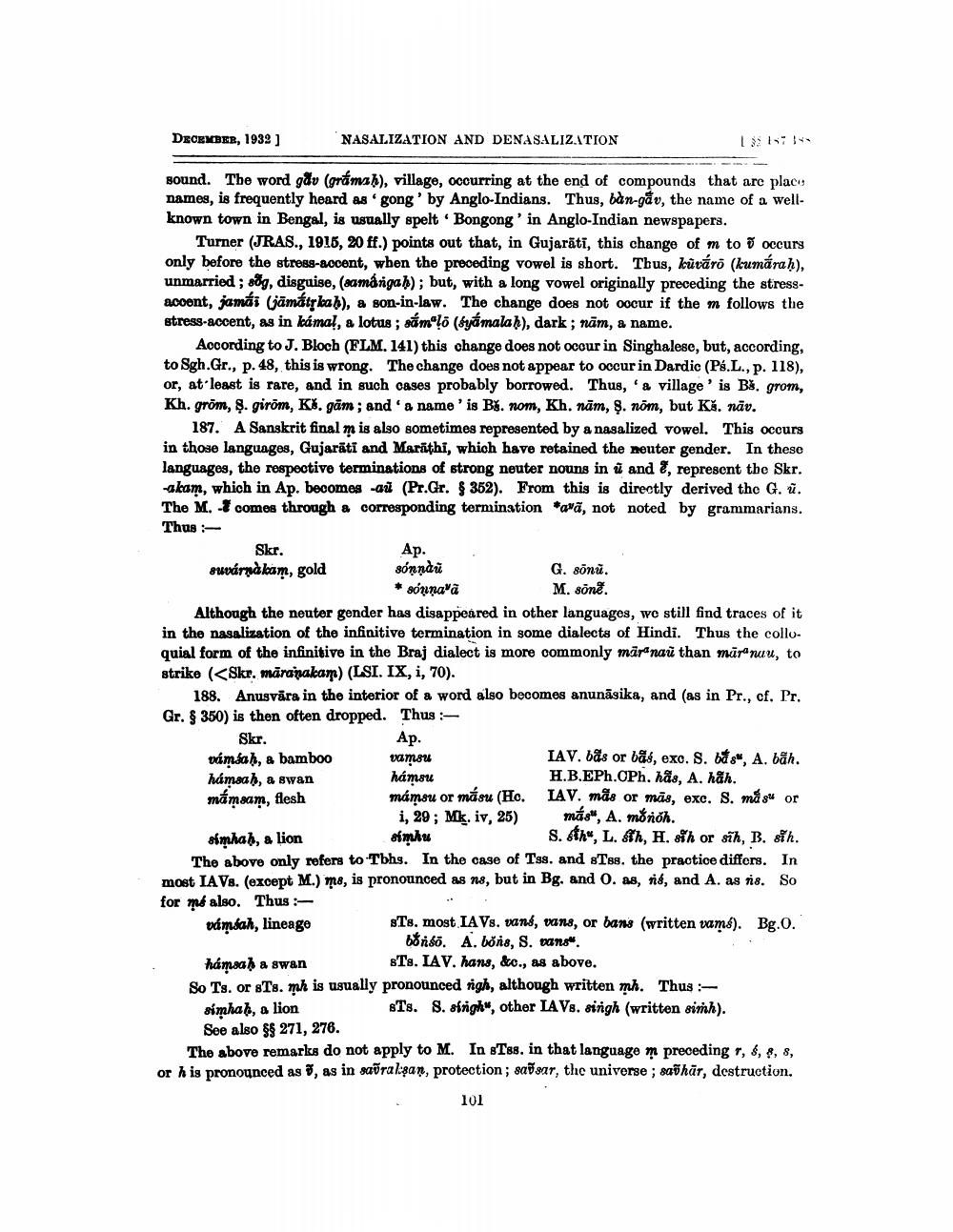________________
DECEMBER, 1932]
NASALIZATION AND DENASALIZATION
sound. The word gav (grámah), village, occurring at the end of compounds that are place names, is frequently heard as 'gong' by Anglo-Indians. Thus, bàn-gav, the name of a wellknown town in Bengal, is usually spelt Bongong' in Anglo-Indian newspapers.
Turner (JRAS., 1915, 20 ff.) points out that, in Gujarati, this change of m to occurs only before the stress-accent, when the preceding vowel is short. Thus, kúvárō (kumáraḥ), unmarried; 88g, disguise, (samángah); but, with a long vowel originally preceding the stressaccent, jamái (jämátykah), a son-in-law. The change does not occur if the m follows the stress-accent, as in kámal, a lotus; sám lo (byamalah), dark; nām, a name.
According to J. Bloch (FLM. 141) this change does not occur in Singhalese, but, according, to Sgh.Gr., p. 48, this is wrong. The change does not appear to occur in Dardic (Pé.L., p. 118), or, at least is rare, and in such cases probably borrowed. Thus, a village' is Bs. grom, Kh. grōm, ş. girōm, Kš. gām; and 'a name' is Bs. nom, Kh. nām, ṣ. nōm, but Kš. nāv.
6
Skr. audrybam, gold
187. A Sanskrit final m is also sometimes represented by a nasalized vowel. This occurs in those languages, Gujarati and Marathi, which have retained the neuter gender. In these languages, the respective terminations of strong neuter nouns in û and &, represent the Skr. -akam, which in Ap. becomes au (Pr.Gr. § 352). From this is directly derived the G. u. The M. - comes through a corresponding termination *ava, not noted by grammarians. Thus :
1 $2 187 188
Ap.
sh
Skr. vámśaḥ, a bamboo hámsah, a swan mámsam, flesh
G. sõnu.
M. sōně.
* sónņa"ä
Although the neuter gender has disappeared in other languages, we still find traces of it in the nasalization of the infinitive termination in some dialects of Hindi. Thus the colloquial form of the infinitive in the Braj dialect is more commonly maranau than māranau, to strike (<Skr. maranakam) (LSI. IX, i, 70).
188. Anusvära in the interior of a word also becomes anunāsika, and (as in Pr., cf. Pr. Gr. § 350) is then often dropped. Thus :
Ap.
vamsu
kámu
mámou or másu (Ho. i, 29; Mk. iv, 25) simhu
IAV. bas or bas, exc. S. bas", A. bäh. H.B.EPh.CPh. has, A. hah. LAV. mas or mas, exc. S. masu or má", A. m.
S. Ah, L. Ah, H. sth or sih, B. sih.
simhaḥ, a lion
The above only refers to Tbhs. In the case of Tss. and sTss. the practice differs. In most IAVs. (except M.) ms, is pronounced as ns, but in Bg. and O. as, ns, and A. as ns. So for me also. Thus :
vah, lineage
STs. most IAVs. vans, vans, or bans (written vams). Bg.O. bonso. A. bons, S. vans".
STs. IAV. hans, &c., as above.
hámsah a swan
So Ts. or sTs. mh is usually pronounced nigh, although written mh. Thus :STs. S. singh", other LAVs. singh (written simh).
simhab, a lion
See also §§ 271, 276.
The above remarks do not apply to M. In sTss. in that language m preceding r, §, §, s, or his pronounced as , as in sauraksan, protection; savsar, the universe; sahār, destruction.
101




